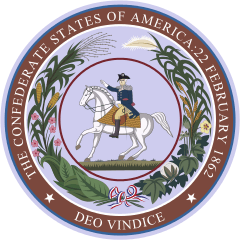William Alexander Graham
| William A. Graham | |
|---|---|
 | |
| Confederate States Senator from North Carolina | |
|
In office February 18, 1864 – May 10, 1865 | |
| Preceded by | Edwin G. Reade |
| Succeeded by | Constituency abolished |
| 20th United States Secretary of the Navy | |
|
In office August 2, 1850 – July 25, 1852 | |
| President | Millard Fillmore |
| Preceded by | William B. Preston |
| Succeeded by | John P. Kennedy |
| 30th Governor of North Carolina | |
|
In office January 1, 1845 – January 1, 1849 | |
| Preceded by | John M. Morehead |
| Succeeded by | Charles Manly |
| United States Senator from North Carolina | |
|
In office November 25, 1840 – March 3, 1843 | |
| Preceded by | Robert Strange |
| Succeeded by | William Haywood |
| Member of the North Carolina Senate | |
| Member of the North Carolina House of Commons | |
|
In office 1833–1840 | |
| Personal details | |
| Born |
William Alexander Graham September 5, 1804 Lincolnton, North Carolina, US |
| Died |
August 11, 1875 (aged 70) Saratoga Springs, New York, US |
| Political party |
Whig (Before 1860) Constitutional Union (1860–1861) Democratic (1861–1865; 1868–1875) National Union (1865–1868) |
| Spouse(s) | Susannah Sarah Washington Graham |
| Children | Ten children |
| Alma mater | University of North Carolina, Chapel Hill |
William Alexander Graham (September 5, 1804 – August 11, 1875) was a United States Senator from North Carolina from 1840 to 1843, a Senator later in the Confederate States Senate from 1864 to 1865, the 30th Governor of North Carolina from 1845 to 1849 and U.S. Secretary of the Navy from 1850 to 1852, under President Millard Fillmore. He was the Whig Party nominee for vice-president in 1852 on a ticket with General Winfield Scott.
Education
Graham was born at Vesuvius Furnace near Lincolnton, North Carolina.[1] His Scots-Irish grandfather James Graham[2] (1714–1763) was born in Drumbo, County Down, Northern Ireland and settled in Chester County in the Province of Pennsylvania. William A. Graham graduated from Pleasant Retreat Academy and the University of North Carolina at Chapel Hill, where he was a member of the Dialectic Society. He studied law, was admitted to the bar in 1825, and commenced practice in Hillsborough.
Political career
From 1833 to 1840 Graham was a member of the North Carolina House of Commons from Orange County, serving twice as speaker.
In 1840 Graham was elected as a Whig to the United States Senate to fill the vacancy caused by the resignation of Robert Strange, and served from November 25, 1840, to March 3, 1843. In the Twenty-seventh Congress he was chairman of the Senate Committee on Claims. His older brother, James Graham, had been representing North Carolina in the House since 1833.
From 1845 to 1849 Graham was Governor of North Carolina. Having declined appointments as ambassador to Spain and Russia in 1849, he was appointed Secretary of the Navy in the cabinet of President Millard Fillmore in 1850, and served until 1852. In the 1852 presidential election he was the unsuccessful Whig nominee for vice president, as Winfield Scott's running mate. The ticket only carried 42 electoral votes from the four states of Kentucky, Massachusetts, Tennessee, and Vermont. When he Returned to North Carolina, he was a member of the state senate from 1854 to 1866, and senator in the Confederate Senate from 1864 to 1865.
Later life and legacy
In 1866 Graham was once again elected to the United States Senate, but because North Carolina had not yet been readmitted to the Union, he did not present his credentials. From 1867 to 1875 he was a member of the board of trustees of the Peabody Fund, which provided educational assistance to the post-Civil War South. From 1873 to 1875 he was an arbitrator in the boundary line dispute between Virginia and Maryland. He died in Saratoga Springs, New York, and is buried in the Presbyterian Church Cemetery in Hillsborough.
The United States Navy ship, USS Graham (DD-192), the World War II Liberty ship SS William A. Graham, and the city of Graham, North Carolina were all named for him, as was Graham County, North Carolina.[3]
Montrose Gardens, located in Hillsborough, North Carolina, is one of Graham's former estates and still features some of the structures Graham and his family had built on the property. He lived in the Nash-Hooper House at Hillsborough from 1869 until 1875.[4] The house was declared a National Historic Landmark in 1971.[5] | added = November 11, 1971[6]
One of Graham's sons, also named William A. Graham, became a state legislator and state agriculture commissioner. Two others, Augustus and John, also became politicians, while a daughter, Susan, married Walter Clark.
References
- ↑ Survey and Planning Unit Staff (July 1974). "Vesuvius Furnace" (pdf). National Register of Historic Places - Nomination and Inventory. North Carolina State Historic Preservation Office. Retrieved 2015-02-01.
- ↑ http://www.familysearch.org/eng/default.asp
- ↑ Gannett, Henry (1905). The Origin of Certain Place Names in the United States. Govt. Print. Off. p. 140.
- ↑ Charles W. Snell (March 27, 1971). "National Register of Historic Places Inventory-Nomination: Nash-Hooper House (William Hooper House)" (pdf). National Park Service. and Accompanying two photos, exterior, from 1969 and 1971 (32 KB)
- ↑ "Nash-Hooper House". National Historic Landmark summary listing. National Park Service. Retrieved 2008-02-26.
- ↑ National Park Service (2007-01-23). "National Register Information System". National Register of Historic Places. National Park Service.
- United States Congress. "William Alexander Graham (id: G000362)". Biographical Directory of the United States Congress.
| United States Senate | ||
|---|---|---|
| Preceded by Robert Strange |
United States Senator (Class 3) from North Carolina 1840–1843 Served alongside: Willie Mangum |
Succeeded by William Haywood |
| Political offices | ||
| Preceded by John Morehead |
Governor of North Carolina 1845–1849 |
Succeeded by Charles Manly |
| Preceded by William Preston |
United States Secretary of the Navy 1850–1852 |
Succeeded by John Kennedy |
| Party political offices | ||
| Preceded by Millard Fillmore |
Whig nominee for Vice President of the United States 1852 |
Succeeded by Andrew Donelson |
| Confederate States Senate | ||
| Preceded by Edwin Reade |
Confederate States Senator (Class 1) from North Carolina 1864–1865 Served alongside: William Dortch |
Constituency abolished |





